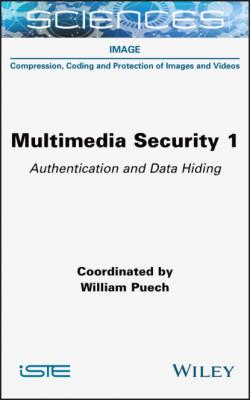Multimedia Security, Volume 1. William Puech
Чтение книги онлайн.
Читать онлайн книгу Multimedia Security, Volume 1 - William Puech страница 7

SCIENCES
Image, Field Director – Laure Blanc-Feraud
Compression, Coding and Protection of Images and Videos, Subject Head – Christine Guillemot
Multimedia Security 1
Authentication and Data Hiding
Coordinated by
William Puech
First published 2022 in Great Britain and the United States by ISTE Ltd and John Wiley & Sons, Inc.
Apart from any fair dealing for the purposes of research or private study, or criticism or review, as permitted under the Copyright, Designs and Patents Act 1988, this publication may only be reproduced, stored or transmitted, in any form or by any means, with the prior permission in writing of the publishers, or in the case of reprographic reproduction in accordance with the terms and licenses issued by the CLA. Enquiries concerning reproduction outside these terms should be sent to the publishers at the undermentioned address:
ISTE Ltd
27-37 St George’s Road
London SW19 4EU
UK
John Wiley & Sons, Inc.
111 River Street
Hoboken, NJ 07030
USA
© ISTE Ltd 2022
The rights of William Puech to be identified as the author of this work have been asserted by him in accordance with the Copyright, Designs and Patents Act 1988.
Any opinions, findings, and conclusions or recommendations expressed in this material are those of the author(s), contributor(s) or editor(s) and do not necessarily reflect the views of ISTE Group.
Library of Congress Control Number: 2021948467
British Library Cataloguing-in-Publication Data
A CIP record for this book is available from the British Library
ISBN 978-1-78945-026-2
ERC code:
PE6 Computer Science and Informatics
PE6_5 Cryptology, security, privacy, quantum cryptography
PE6_8 Computer graphics, computer vision, multi media, computer games
Foreword by Gildas Avoine
Gildas AVOINE
Director of the CNRS Computer Security Research Network, INSA Rennes, University of Rennes, IRISA, CNRS, France
French academic and industrial research in cybersecurity is at the forefront of the international scene. While France cannot claim to have sovereignty over cybersecurity technologies, it undeniably possesses a wealth of skills, as French expertise covers all areas of cybersecurity.
Research in cryptography illustrates French excellence, but it should not overshadow other domains where French influence is just as remarkable, including formal methods for security, protection of privacy, security of systems, software and networks, security of hardware systems and multimedia data security, according to the classification proposed by the CNRS Computer Security Research Network (GdR).
The security of multimedia data is covered in this book. The evolution of our society from the written word to sound and image, with the notable arrival of the mobile phone and the democratization of the Internet has brought about new security needs. These are only the beginning of the transformation of our society, and the recent deployment of videoconferencing shows that research into the security of multimedia data is constantly confronted with new scientific challenges.
The complexity of the subject and its multidisciplinary dimension, which primarily combines signal processing and cryptography, are perfectly illustrated by the variety of subjects detailed throughout this book. The chapters thus reveal the scientific obstacles to be dealt with by the community, by anchoring them in real scenarios, such as the fraudulent copying of films, the deception of artificial intelligence or the spreading of doctored images on social media.
This book, made up of two volumes, is thus promised to become a reference in the field of multimedia data security, an introduction that is both exhaustive and in-depth that students, engineers and researchers will be able to appreciate through more than 600 pages enriched with numerous references. Everyone can indulge in their favorite kind of reading, whether linear or random.
Finally, I would like to thank all of the authors for their commitment to supporting the scientific community, and I would particularly like to thank William Puech for editing this edition of the book. William, alongside Patrick Bas and then Caroline Fontaine, is responsible for the theme of multimedia data security within the Computer Security GdR, thus allowing the entire cybersecurity community to better understand this fascinating subject.
Happy reading!
Foreword by Cédric Richard
Cédric RICHARD
Director of the CNRS GdR ISIS, Côte d’Azur Observatory, University of Côte d’Azur, Nice, France
With the relentless increase in bandwidth and storage space, as well as the proliferation of mobile devices and the development of new standards, multimedia data is affecting our societies by changing the way that we access data and information. It is also changing our relationship to culture, by transforming interactions between individuals and their relationships with organizations. Multimedia activities are present in all major sectors of activity (security, health, telecommunications, etc.) and have supported their successive developments because of the common backbone they build, from information support to the application and user.
In this context, by protecting confidentiality and copyright, verifying integrity, analyzing and authenticating content, tracing copies and controlling access, particularly critical questions about multimedia data security are being asked. For example, the protection strategies implemented must take into account the specific needs of multimedia while meeting the requirements of